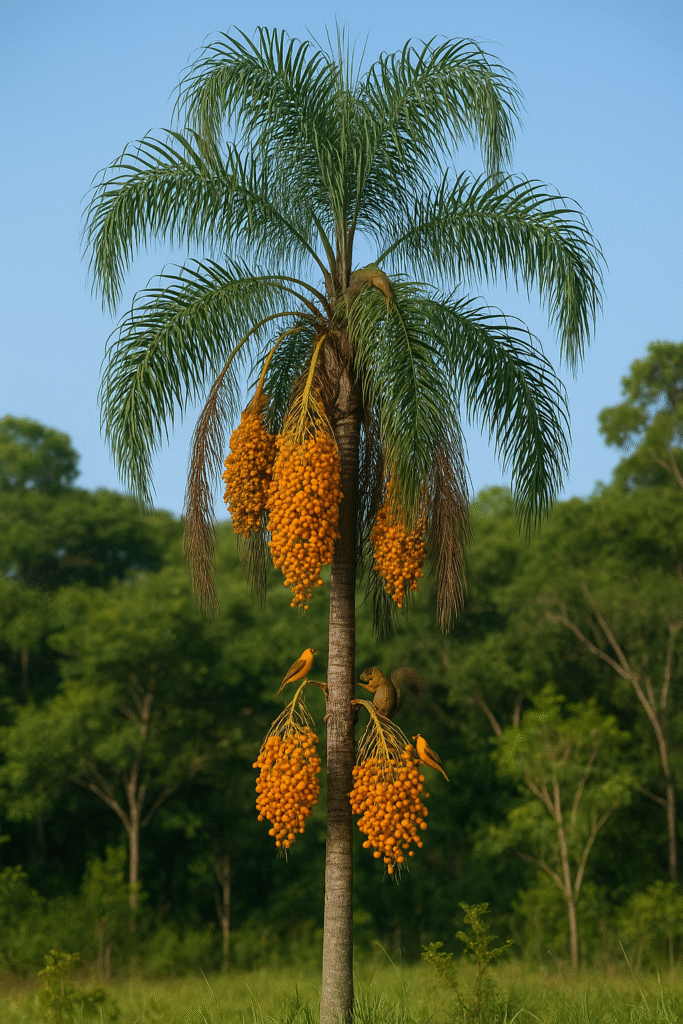The Queen Palm, scientifically known as Syagrus romanzoffiana, is a tropical palm tree native to Brazil that has become increasingly popular in both urban landscaping and residential gardens. With its graceful silhouette, fast growth, and ecological benefits, the Queen Palm is an ideal choice for those seeking beauty and sustainability in their outdoor spaces.
In this article, you’ll discover everything you need to know about this stunning Brazilian palm: its origin, features, how to grow it, environmental importance, and interesting facts.
Origin and Distribution
The Queen Palm is native to the Atlantic Forest biome and can be found throughout Brazil, particularly in the South, Southeast, and Central-West regions. It also grows naturally in neighboring countries such as Argentina, Paraguay, and Uruguay.
Thanks to its adaptability, it thrives in various environments, from forested areas and riverbanks to open fields and urban parks.
Key Characteristics of the Queen Palm
Syagrus romanzoffiana is a medium to tall palm, typically reaching heights between 10 and 20 meters (33–66 feet). Its most notable features include:
- A solitary, ringed trunk measuring around 30 to 50 cm in diameter;
- Long, arching fronds that can grow up to 3 meters (10 feet) long;
- Bright orange fruits, which are fibrous and highly attractive to birds and mammals;
- Yellow inflorescences that bloom in large clusters, attracting various pollinators.
Unlike some slower-growing palms, the Queen Palm grows relatively quickly when properly maintained.
How to Grow the Queen Palm
One of the greatest advantages of this palm is how easy it is to grow. It adapts to a wide range of conditions and requires minimal care once established.
1. Light
The Queen Palm prefers full sun, although it can tolerate partial shade when young.
2. Soil
It thrives in fertile, well-draining soil. For best results, mix organic compost with sand to encourage strong root development.
3. Watering
Water regularly during the first couple of years. Once established, it becomes drought-tolerant.
4. Fertilization
Use organic compost or balanced NPK fertilizer (e.g., 10-10-10) every three months, especially during spring and summer.
5. Spacing
Since this is a large palm, plant it at least 4 meters (13 feet) away from buildings or other large trees to give it space to grow properly.
Environmental Benefits
Beyond its decorative appeal, the Queen Palm is an ecological asset. Its fruit serves as a food source for many animals, including:
- Toucans
- Parrots and macaws
- Coatis
- Capuchin monkeys
- Various bird species
- Pollinating insects
For that reason, it’s often included in reforestation and biodiversity restoration projects. It promotes native wildlife and contributes to local ecosystems.
Landscaping Uses
This palm is commonly used in parks, urban streets, public squares, central medians, and private gardens. Its upright, elegant form creates a dramatic tropical look.
It’s particularly well-suited for:
- Lining walkways and driveways
- Garden focal points
- Tropical-themed landscaping designs
- Wildlife gardens that attract birds
Plus, it’s thorn-free, making it a safe addition to areas frequented by children or pets.
Fun Facts About the Queen Palm
- The fruit is not typically consumed by humans, but it is rich in nutritional oils and studied for potential industrial uses.
- Its lightweight yet durable wood is occasionally used in handcrafted goods.
- It helps improve air quality in urban environments by absorbing CO₂ and increasing humidity.
Conclusion
The Queen Palm (Syagrus romanzoffiana) is more than just a pretty tree. It’s a fast-growing, low-maintenance palm that supports wildlife, enhances landscapes, and brings a touch of the tropics to any space.
Whether you’re a landscape architect, an environmentalist, or a homeowner looking to enhance your garden, this Brazilian native is a brilliant addition to your planting list.
Add it to your garden, and enjoy not just the beauty, but also the birds and life it brings!

Discover Rare and Beautiful Succulents
Looking for unique, healthy, and eye-catching succulents? At Leaf & Clay, you’ll find exotic varieties perfect for any indoor garden or tropical plant collection.
Explore their curated selection and get inspired to grow something extraordinary today!

